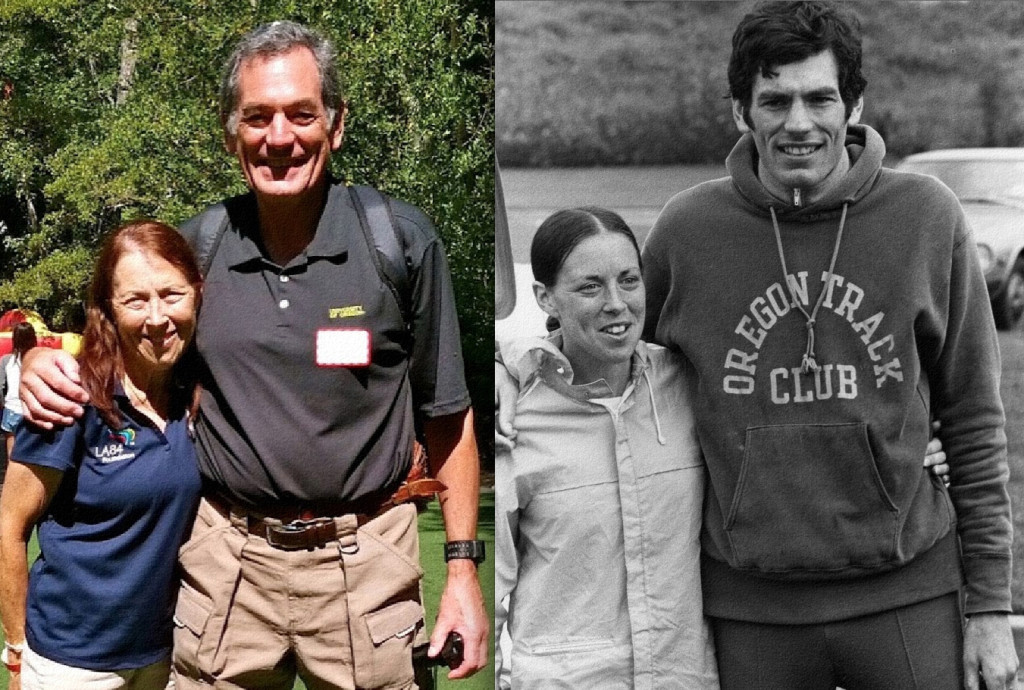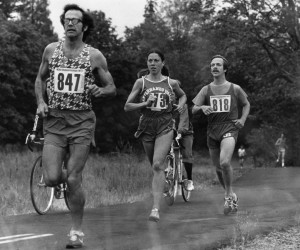October 12, 1975

Eugene, Oregon – October 12, 1975
I was on a pre-race run a few days before marathon day, getting a tour of Eugene, Oregon on my first trip there. The town was mourning the death of Prefontaine, from his accident just five months earlier. I’ve never experienced anything like this before, an entire community mourning.
Eventually, the running conversation included the inevitable question: “So what sort of time are you aiming for?” Somehow it just rolled off my tongue, “six-minute miles,” I caught myself saying. That comment was met with dead silence, followed by hushed murmurs while doing the math. That must have sounded presumptuous!
On race day, it all came together. I chose Eugene, knowing that the course would be relatively flat, fast, cool, maybe drizzly, and most importantly, accurately measured. The NIKE-Oregon Track Club Marathon was run over what was to be the men’s 1976 Olympic Marathon Trials course the next year. It was a sort of dress rehearsal as it were. The race successfully met all of those predictions. Plus, I came into the race feeling good about my workouts. Even my coach, Laszlo Tabori, said at the close of that last interval workout the week before I departed, “you’re ready.” That comment came after my two 5-minute mile repeats I did in the middle of workout, and even though I questioned the connection, I trusted him to know these things. Joe Henderson printed that workout in his book “Road Racers and Their Training” —
Tuesday: 2 1/2 mile warm-up; 15 x 100 shakeups – 8 medium, 7 hard; 10 x 400 with 3 hard (73, 71, 72 seconds); 2 1/2 laps easy; 8 x 150 – 2 medium, 1 hard; 5 laps hard (5:13 mile); 2 laps easy; 5 laps hard (5:17 mile); 2 1/2 laps easy; 10 x 200 – 2 hard, 2 medium; 2 laps easy; 12 x 100 shakedowns – 2 medium, 1 hard.
Monday and Wednesday, I did my favorite workout: “25-lappers” on the track both mornings, plus an 8-mile run one evening and a 9-mile run the other. Thursday was a modified interval workout, easier than Tuesday’s because I had a race on Saturday. Friday was a brief pre-race run. Saturday I ran a 16:55 cross country 5K race. Sunday I did my last long run of 19 miles before departing for Eugene the next week. Those 25-lap workouts were the best! You could do them anywhere, anytime, without using a stopwatch. I ran a continuous 25 laps consisting of a 5-lap warm-up, then repeated sets of four laps per set: 2 x 100 medium, 2 x 150 build-up, 2 x 100 medium and 2 x 100 hard with an easy jog on the curves in between each.
My friends in Eugene, Janet and Tom Heinonen, arranged for my housing with the Ledbetter family. Young Lili Ledbetter was a local high school track star. We became good friends and her mom made the best ever zuchinni bread complete with homegrown filbert nuts. I jokingly say that my race was fueled on zucchini bread, I enjoyed it so much. Throughout the race, Janet and Lili could be found bicycling from station to station, either making sure my bottles of Gookinaid were waiting for me, or more so to check on my progress and splits.
I once said in a Sports Illustrated article that “there were days I could run forever. . . ” and gratefully, this was one of those days. To say it felt effortless sounds overly confident, but it was true. In review, my splits averaged 6:02 per mile, my slowest was 6:08 or :10, and my last 5 miles were at 5:55. I’ve said it before, I cannot do the math when I’m running tired, but that day when I heard my 20-mile split, I could do the math that told me I was ahead of pace, so I immediately picked up the pace and took off, leaving the group of male runners in my company. Looking back, a move like that with six miles to go could have ended badly, but that day it worked.
Look at the picture above, the one with only me in the frame – the one with my glassy-eyed look on my face and not smiling. A sport psychologist once showed me a group of racing photos and pointed out that he could predict the athlete who was going to run well — the one with glassy-eyed look, the one who is focused and able to shut out all distractions. That was me, definitely focused exactly in that way, on exactly the right day.
I approached the finish line in 11th place and someone yelled from the sidelines, “Catch one more guy! Top ten get watches!” But I knew I had something more valuable on the line. What I felt upon finishing, besides pure elation, was a sense of no time passing. Having experienced more than my share of surgeries over my career, I can tell you that it felt like I was coming out of a deep anesthesia slumber, wondering when the procedure was going to begin only to discover it was all over. It was that kind of sense of no time passing. Almost an out of body experience because simultaneously, I had the clear recollection of every mile run, every water station, every split, every inch of the course.
Thanks to my friend, photographer Doug Schwab, I have great photos and a great story written by my friend, Tim Wason. Thanks to Janet Heinonen, it was written up in the OTC newsletter, so the experience was well documented.
Often I wished I could bottle up and patent that formula which made for the “peak performance” and pull it out of my repertoire for every race. However, it was simply one of those marvelous times that I will always treasure, feeling fortunate to ever have such an experience.
Memories of the day, on the 40th Anniversary of my best WR, the first sub-2:40, officially 2:38:19.
Photos made possible thanks to Doug Schwab. Many thanks to Janet Heinonen for support and encouragement on that day and ever since. Thanks to Jon Anderson for the “then and now” photo. Thanks to all for our close friendships then, now, and forever more.
Today, I am feeling especially grateful for a new friend, Katie Holmes, who gave me a priceless gift with a book review of my memoir. Please visit her blog “Run Young 50” – http://runyoung50.co.uk/jacqueline-hansen-the-womens-marathon-revolution/










When you’ve ‘been there’ as you have Jacqueline, a recollection like this takes on a special meaning, a certain gravity that makes it the more compelling to read. Thanks for sharing!
You are very welcome, Scott! Coming from you means a lot. You are an historian of our sport and I appreciate your kind words.
The quote, “You learn something new everyday” couldn’t be more true for me today. Jacqueline, what a brilliant performance and enjoyable read, thank you for both! I appreciate the history lesson and am a little embarrassed I am just learning it today. #NeverTooLatetoLearn
Thank you for kind words Liz! I too learn something new every day of my life. Stay curious! No apologies necessary. Agreed – we are never ever too late to learn . . . and to grow.